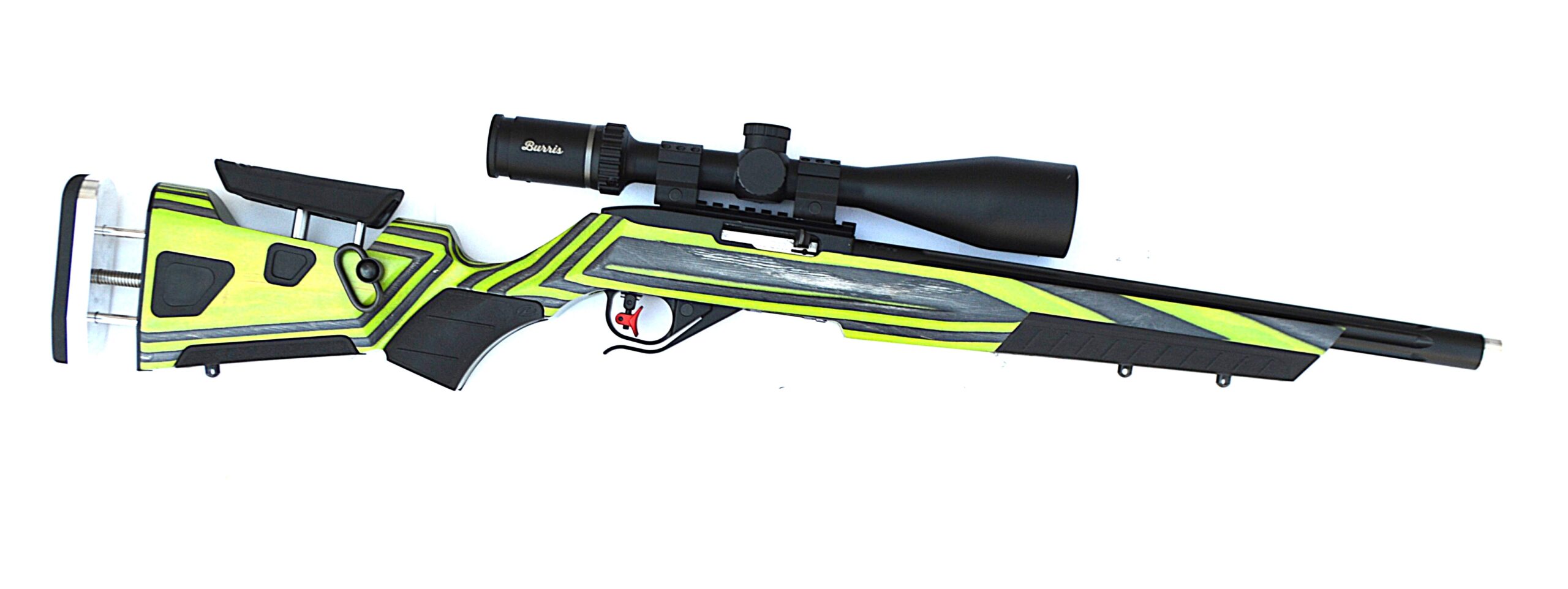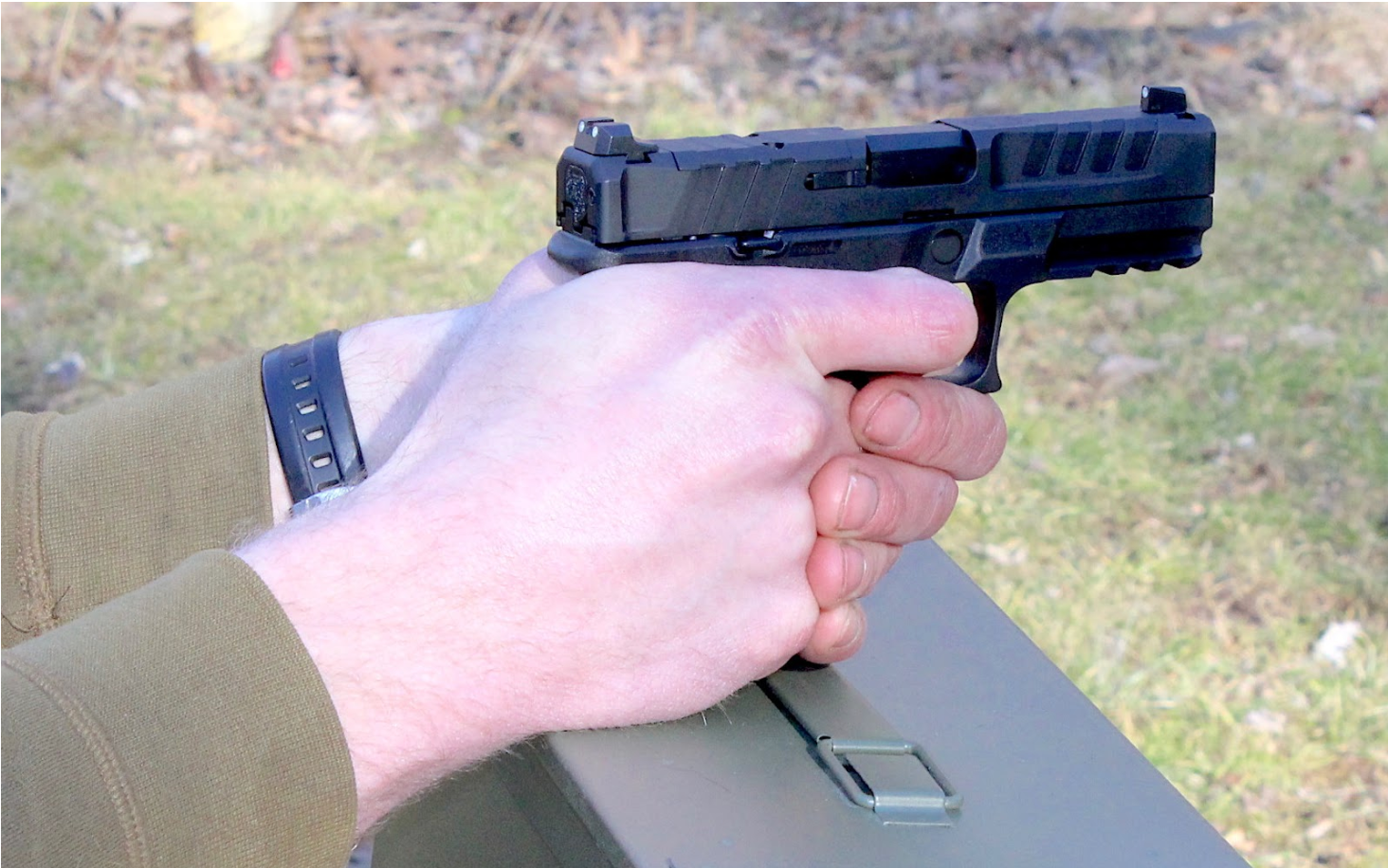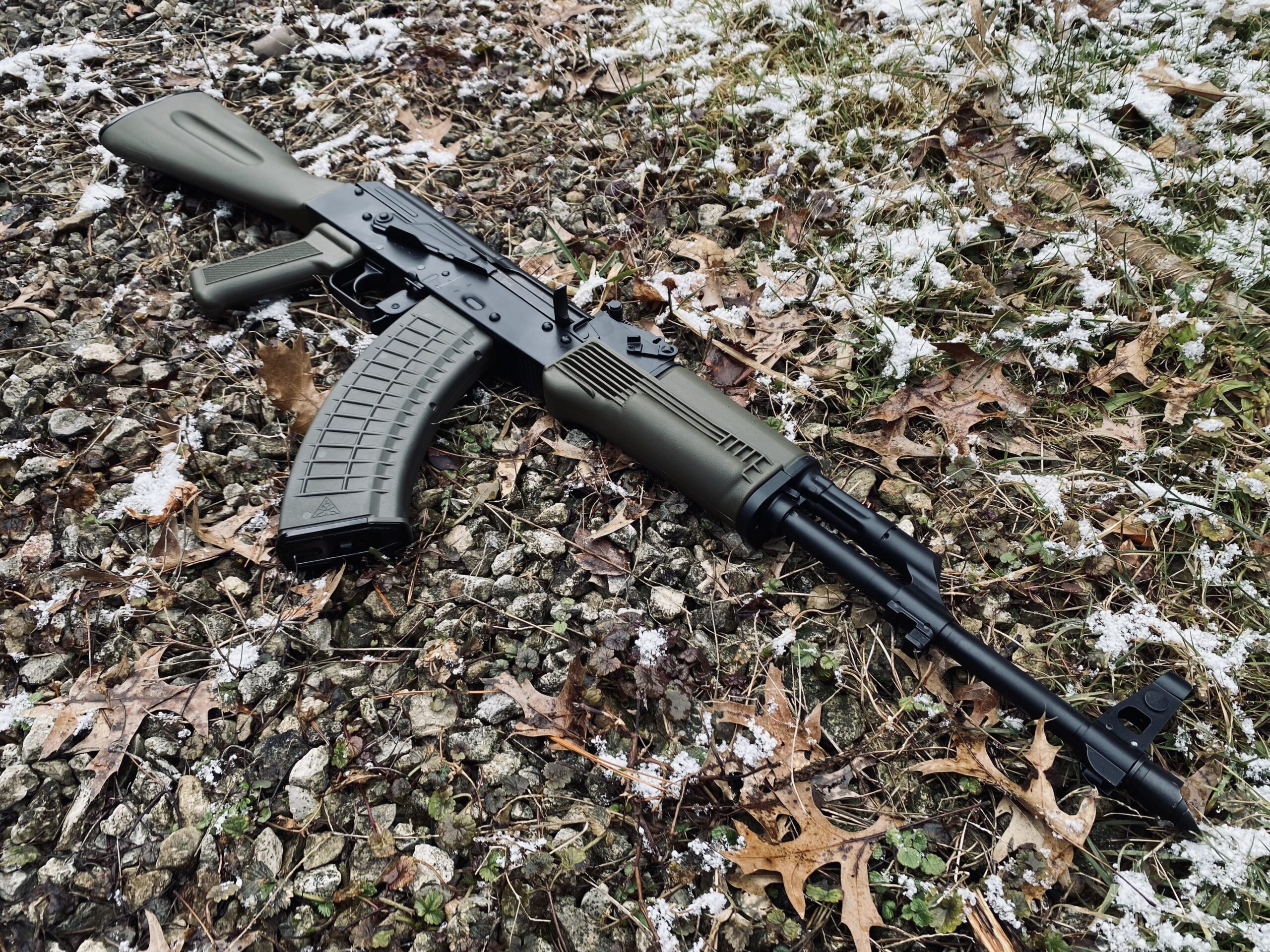The Czechoslovakian Sa Vz. 58 assault rifle has to rank high as one of the least understood and most underappreciated military rifles of the twentieth century. Case in point: for many years I thought that it was simply a copy of the AK-47. But I’m not alone: I’ve even seen it described in books as being an “AK.” However, outward appearances aside, they only thing the Vz. 58 has in common with an AK-47 is the round it shoots: the M43 (7.62 x 39mm). In fact, internally this rifle has more in common with Walther P38s, Beretta 92s, Brens, and Glocks than it does with an AK-47. Over the past couple years, I had the opportunity to test two civilian-legal adaptations of the original Czech design: the D-Techniks Vz. 58 “Sporter”, and a Century Arms International Inc. parts kit build called the “Vz. 2008.” . . .
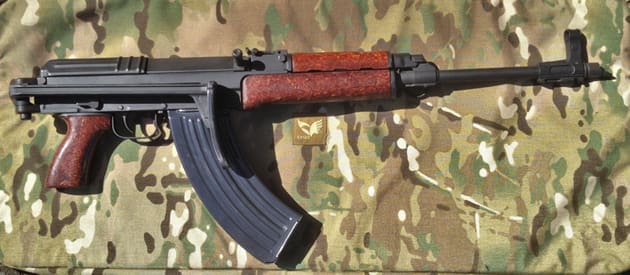
A couple of introductory points: First, a short primer on terminology. The “Sa” is an abbreviation for the Czech word “Samopal,” which I am told means something along the lines of “automatic firearm” or “submachine gun.” The “Vz.” is an abbreviation for “Vzor,” which means “model.” You will see folks refer to these guns as “CZ 58s,” but that name is technically not correct, despite the fact that CZ did manufacture them.
Second, I should point out the first photo, above, shows a modern, pimped-out sporter version of the Vz. 58 with furniture provided to TTAG courtesy of the Mako Group/and FAB Defense. I review these accessories separately in a companion article. The second photo shows a common parts kit gun with OEM furniture. This particular sample is a rifle from Century Arms International known as the Vz. 2008.
And with that, let’s start with a little history….
History and Evolution of the Vz. 58
When it comes to making military and sporting small arms, the country formerly known as Czechoslovakia had a long and rich history that dates back to the 17th Century. Prior to World War II, Czech-made small arms were prized for their innovation, quality machining, and attention to detail. As an example, the VB Vz. 26 and its later variants became the template for both the British Bren gun and the Japanese Type 96 / 99 machine gun. The British also built a licensed version of the Tk Vz. 37, an innovative belt-fed 7.92 x 57 machinegun that featured an adjustable cyclic rate for use against ground and air targets. Czech-made Vz. 24 Mausers were considered to be among the finest bolt action rifles in the world, and were widely exported.
During World War II, Czech arms manufacture fell under the control of the Germans. The Nazis made extensive use of many of the Czechoslovakian arms factories to supply both the SS and the Wehrmacht. For example, Mauser K98s, MG34s, and other weapons were produced at the world-renowned Československá zbrojovka, akc. spol. (now called “Zbrojovka Brno a.s.”) in the city of Brno. This city is also referred to as “Brunn,” esp. by German-speaking people. This factory produced German-designed rifles in WWII, and today Mauser collectors will frequently see samples of K98s with this factory’s “Dot” code. The Germans also oversaw production of German Mausers at a lesser-known factory located in the Slovakian town of Provazska Bistrica. These rifles featured the “Dou” factory code, as shown in the photo below:
After the Soviets ousted the Germans from Czech territory in 1945, they allowed the formation of a new coalition government. Sympathy for both the Soviets and Communism ran high, and the country created strong ties to the Soviet Union. In 1946, candidates the Communist Party of Czechoslovakia (“KSC”) gained 38% of the vote in the first national elections. But the commies were not content with sharing power, because, as history teaches us, totalitarianism is the silent partner of Communism. So with the help of their Soviet overloads, KSC launched a successful coup d’état in 1948, in which the non-KSC parties were driven out of the coalition government. Czechoslovakia became one of the most loyal of the new Soviet puppet states.
In the years following World War II, Czechoslovakia recognized that technological inovations were driving a need for lightweight, compact infantry rifles with high rates of fire. Nonetheless, the first post-war design to be fielded by the Czechs, the Vz. 52, was not such a design. Rather, the Vz. 52 was a tilting-bolt lock action with a short-stroke gas piston operation; similar in appearance and function to the Simonov SKS, MAS 49, or a FN 49. It used a new, proprietary, 7.62 x 45 mm round, which would prove to be short-lived.
But the Vz. 52 was merely a stop-gap, and even before it was adopted, the Czechs began development on an improved rifle that could combine select-fire and higher magazine capacity of the submachine gun with the longer range and energy of the self loading rifle. Unlike other satellite states such as Poland, Hungary, and Romania, however, the Soviets rewarded Czech loyalty with some degree of autonomy: they allowed the Czechs to pursue their own rifle design rather than insisting on the production of a Kalashnikov clone.
In 1951, three independent engineering teams were working on designs for a new assault rifle based on the 7.62 x 45 round. The first was the Koucky brothers (future CZ 75 designers), who submitted the ZK 503. The second was the Czech gun designer Vaclav Holek, who had previously invented the ZB 26. His submission was the ZB 530. Finally, a team headed by a 25-year-old gun designer named Jiří Čermák (1926–2006) submitted the “Cz 515” prototype. Though seemingly an unlikely candidate to run such an operation, Mr. Čermák had gained considerable experience as part of the CZ team that designed the Vz. 52.
The Čz 515 fired from the open bolt – a requirement specified by the Czech army. During testing, the Čz 515 did not meet military accuracy requirements, a fault attributed to the open-bolt design. To address the issue, Mr. Čermák re-designed a second prototype rifle, the Čz 522, to fire from the closed bolt position. In addition, the barrel of this new prototype was shortened to 350 mm and had the charging/cocking handle attached directly to the bolt carrier.
By 1954, the designs from the three competing engineering firms were put to a series of tests by the both the Czech Army and the Red Army in the Soviet Union. Although this testing revealed that all three designs needed further refinement, the Soviets praised the ČZ 522 over the two competing designs.
Around that same time, the KSC had nationalized and centralized virtually all industry in Czechoslovakia, gradually bringing about the end the independent design offices of individual arms factories. In their place, the KSC built a large specialized research and development center, which was initially named “Konstrukta Brno” (after its place of residence in the City of Brno). Jiří Čermák began working at Konstruckta on October of 1954, and development of a new assault rifle began there shortly thereafter at this facility.
Unfortunately, Soviet meddling slowed progress. Specifically, the formation of the Warsaw Pact meant standardization on military ammunition, and the end of the Czech 7.62 x 45 round. Nonetheless, it wasn’t until the first quarter of 1956 that the Soviets were able to provide Czech designers with the technical specifications for the M43 7.62×39 mm cartridge. With the specs for the new round in hand, resumption of design work commenced. However, somewhere in that timeframe, the other two design teams bowed out of the running.
The first of Mr. Jiří Čermák’s prototypes to use the M43 cartridge was the model Sa 56. It was another “close-but-no-cigar” affair. During the next phase of design work, the hammer was replaced with a striker system, in order to achieve a lower cyclic rate of fire. Testing also confirmed that this change increased accuracy in full automatic fire. Additional weight reduction was achieved by manufacturing the magazine from aluminum alloy (the weight savings with the six magazines around 2 pounds). By the time the Czech military accepted the final Sa Vz. 58 design, they had a weapon that was considerably lighter and more compact than an AK-47 or AKM, while achieving better accuracy in semi-automatic mode.
Production of the Sa Vz. 58 commenced in 1959 at the Ceska Zbrojovka Uhersky Brod, a.s. factory (“CZ-UB”) . Located in the town of Uhersky Brod (pop. ~18,000), this company is known to most U.S. shooters simply as “CZ.” CZ-UB produced around 920,000 copies of this weapon system from 1959 to 1984.
Of course, having gone to the dark side, Czechoslovakia was more than happy to supply the world’s worst leftie despots with military arms. It wasn’t long before the Sa Vz. 58 started showing up in the all the world’s garden spots, from Vietnam to Angola to the Ivory Coast. The list of countries that purchased the Vz. 58 for their militaries reads like a nightmare: Cuba, Ethiopia, Nicaragua, Uganda, Libya, Somalia, India, Lebanon, Angola, Mozambique, Iraq, Tanzania, and Grenada.
The good news is that after the cold war “ended,” the Czech people regained their sanity, jettisoned the brutal communists, and joined NATO. Since that time, the Czech Republic has begun to move on to newer rifle designs, thus allowing for the importation of surplus Vz.58s into the U.S.
Overview of the Vz. 58 Design
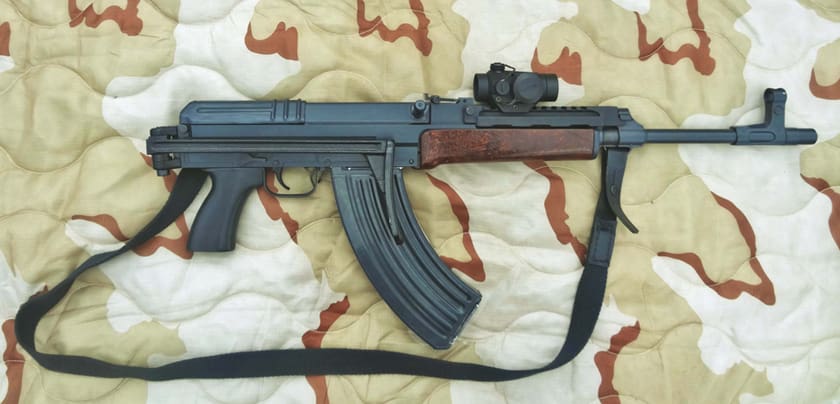
First off: this ain’t no stinkin’ AK. Although outwardly similar to an AK-47, it is important to note at the outset that none of the SA Vz. 58 parts are interchangeable with an AK: not the mags, not the pistol grip, nothing. Nadda. Fuggetaboudit.
When you pick up a Vz. 58, the first thing you will notice is how light and handy it is. In terms of weight and portability, it feels remarkably similar to a M-1 carbine. Even with the milled receiver, the Vz. 58 is more than a pound lighter than a stamped AK-47. And unlike the pistol-caliber M-1 Carbine, this beast will spit out 123 grain rifle-caliber projectiles at over 2200 fps.
The basic features of the Vz. 58 include:
- Milled steel receiver.
- Striker fired (similar to a Glock pistol).
- Short stroke gas piston.
- Reciprocating bolt handle.
- a tilting lock action with a dropping block (similar to Walther P38s or Beretta 92s).
- Bolt hold-open on empty magazine.
- Aluminum alloy 30 round magazines.
- Tangent rear sights, protected post front site.
- No ejection port dust cover (the receiver is completely enclosed by the bolt carrier).
- stripper clip guide to facilitate loading magazines with chargers.
Here’s a photo showing how you can use the bolt carrier as a guide to load mags from chargers:
How the Action Works
As mentioned above, the Vz. 58 is gas operated; it uses a short-stroke gas piston to cycle the action. The bolt assembly of the Vz. 58 consists of four separate pieces: the bolt, the locking lugs, the striker, and the bolt carrier. Note that there is no traditional “hammer” in the trigger pack. The photo below shows the bolt carrier, the striker (at left), as well as the bolt and locking piece:
These two photos show the bolt, the locking piece, and firing pin. Note that the firing pin is not normally removed during field-stripping / cleaning. While I have successfully removed and installed the firing pin, putting the bolt back together is one of those “three hands required” operations. So I don’t recommend taking the bolt apart as part of normal cleaning.
Once a round is fired, gas bled from the barrel sends a gas pistol (i.e. a chrome-plated tappet rod) rearward. This rod slams into the bolt carrier, and a spring returns the tappet rod back to its forward position. Nonetheless, energy is transferred to the bolt carrier, sending it rearward as it rides on rails located inside the receiver. The spent brass casing is pulled out of the chamber and racked over a fixed ejector, which jettisons the casing up and out of the receiver. The rearward force of the bolt carrier cams the locking lugs upward out of their locking recesses.
As the bolt carrier travels rearward, it brings the striker with it. In the process, the striker rolls over the sear. The sear acts as a one way ratchet, and blocks the striker from returning to the forward position as the bolt carrier moves back forward under spring tension. The striker remains locked to the rear under spring tension, as it contains an internal striker spring. The bolt carrier moves back to the forward position, and in the process, strips a new cartridge out of the magazine and into the chamber. The locking lugs are cammed downward and lock the bolt in place.
When the trigger is pressed, the disconnector moves the sear downward, thereby enabling the striker to slam foward under spring tension and hit the back of the short firing pin contained in the bolt. The round’s primer is ignited, and the process starts again.
Background on the Civilian Legal Variants Found in the U.S.
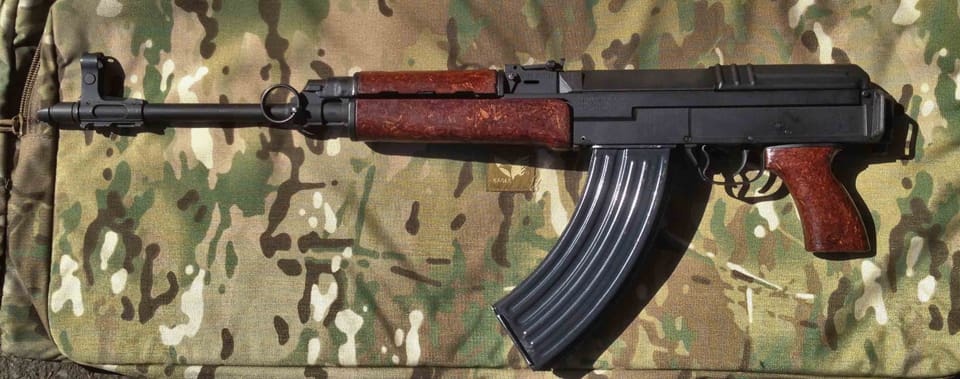
Based on my experience, it appears that U.S. collectors will typically run across five different makes of Vz. 58s on the civilian market. The first are Vz. 58 “Sporters,” manufactured by Czech Small Arms (“CSA”) (formerly known as “D-Techniks”). D-Techniks began exportation of these guns to the U.S. in January of 2006. Collectors will encounter samples with various import marks, including Waffen Werks (“WW”), Tennessee Guns Int. (“TGI”), CzechPoint USA (“CSA”), etc.
To clear up confusion, it is worth noting that CSA and Ceska Zbrojovka Uhersky Brod, a.s., (aka “CZ”) are different companies. Czech Small Arms is a small manufacturing facility located in a town called Jablunka, Czech Republic. CSA currently owns the rights to build the Vz. 58, which it purchased from CZ.
CzechPoint, USA is the current U.S. importer and exclusive distributor for CSA. Before CzechPoint acquired the importer’s license, CzechPoint contracted with WW and TGI to import D-Technik firearms into the U.S. At that time, CzechPoint was acting solely as a distributor. Now that Czechpoint has an importer’s license, it manages both importation and distribution.
The Vz. 58s made by CSA are partially kit guns: the firm hand selects original military issue surplus parts and assembles them onto newly manufactured receivers with new hammer-forged barrels. CSA has been introducing more new parts into the production of their rifles, because surplus parts in excellent condition are getting more and more difficult to find. Although CSA purchases surplus military rifles on the surplus market for these builds, it is getting to the point where many of these parts are in too bad of shape to use on CSA rifles. As a result, CSA is currently manufacturing the following parts in house:
- Receiver
- Polymer furniture
- Trigger guard
- Bolts (in 7.62 x 39 and 5.56 x 45)
- Gas adapter/block
- Front sight base
- Pistons
- strikers
- various screws, pins, and springs
Soon, CSA will be manufacturing receiver covers, bolt carriers, and locking pieces in house.
A second commonly-encountered variant is the Century Arms International Vz. 2008. This is a surplus parts kit gun made on U.S. made receivers machined from 4140 steel, hardened to 40-45 RC. It features a new U.S. made barrel, rumored to be made by Green Mountain, as well as U.S. made “922r compliance parts.” It typically comes with 1 magazine, and a cleaning kit. AIM Surplus currently advertises these at $499 with 5 magazines, a used surplus bayonet and scabbard, and a used pigskin mag pouch, which is admittedly an incredible deal if you are willing to take the risk on a Century product.
A third, more rare type of Vz. 58 found on the secondary market are ones that bear the CZ label: CZ USA contracted with Czechpoint to import “tactical” and “military sporter” models of the Vz.58 into the U.S., from 2007-2010. Ironically, these rifles were “manufactured” by D-Techniks and combining original CZ Sa Vz. 58 components with a new semi-auto only milled receiver, a new trigger mechanism and new fire control parts.
CZ USA purchased both their Vz.58 rifles and Vz. 61 Scorpions from CzechPoint, until CzechPoint made the decision to be the sole distributor and grow the CzechPoint brand. Many people are under the incorrect assumption that CZ USA imported or manufactured the Vz.58 and Vz.61 – that is not the case. CZ USA purchased the Vz.58 and Vz.61s from CzechPoint and their firearms were rebranded by CZ USA.
Fourth, you will also run into U.S. made parts-kit build guns made companies such as Ohio Ordnance Works, Ohio Rapid Fire, or Waffen Werks.
The guns made by Ohio Ordnance Works will be marked “VZ. 2000,” and my understanding is that they started production in 2003 and are still making them, well equipped, for around $1000. Ohio Rapid Fire manufactured Vz. 58s from around 2008-2010, but the company is now defunct. Quality was reportedly spotty on the ORF guns, but I have no first-hand experience with them.
Lastly, it’s possible to encounter one-off parts kit builds made on U.S. made receivers by who knows who. These “bubba-build” guns are the least desirable and should be avoided unless of known provenance or accompanied by a good guarantee / warranty. The now-defunct company “Ohio Rapid Fire” made receivers, and from the internet chatter you read, there were many problems with them being out of spec.
A new company known as “Assault Weapons of Ohio” apparently bought ORF’s inventory and is advertising that they will perform repair and rebuild work on Vz. 58s. Note that D-Techniks also sold stripped receivers for a while. Although they are rare (< 50 in the U.S.), it is consequently the case that D-Techniks marked receiver is not a guarantee of a D-Technik’s build.
To complete this review, I used two different rifles: a 2006-era D-Techniks rifle imported by TGI, and a 2008-era Century Arms Vz. 2008. Both of these guns are part of my personal collection and were obtained from FFL dealers on the open market (as opposed to being test samples from the manufacturers).
CSA: Changes Made to the Civilian Versions
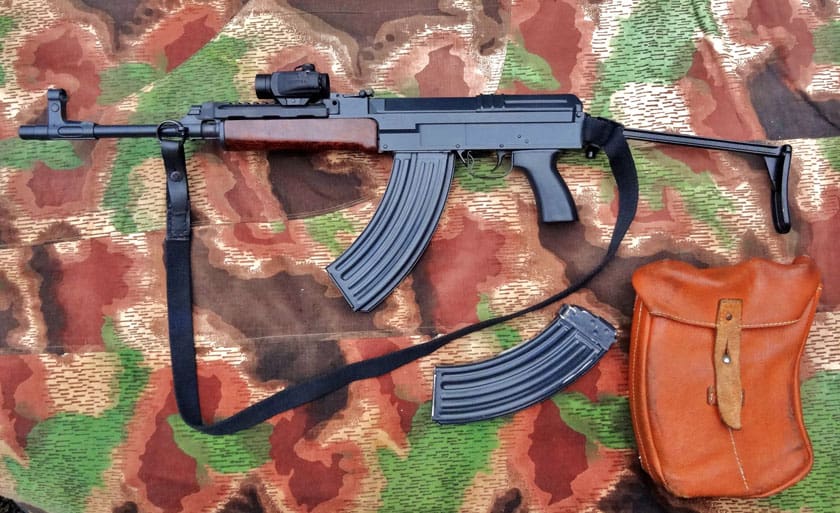
The CSA (formerly “D-Techniks”) rifle is imported into the United States in a “Sa Vz. 58 Sporter” configuration, which features a 10-round single-stack magazine. Once in-country, CzechPoint then converted it back to a “military” configuration. A company called Waffen Werks converted older D-Technik rifles for CzechPoint, because, at the time, Czechpoint only possessed a Type 01 FFL. Currently, CzechPoint imports and does the conversion manufacturing in house.
Czechpoint uses at least 5 U.S.-made parts to fully comply with Title 18, U.S.C., Section 922(r): (1) sear, (2) disconnector, (3) trigger, (4) magazine follower, (5) and magazine floor plate. Of these five aforementioned parts, the first two are made from 4140 steel, while the last three are made from Leona 90 G 60 and Zytel ST 801 polymer. In addition, since U.S. law prevents the importation of semi-automatic rifles with bayonet lugs, all U.S. import Vz. 58 rifles made D-Technics / Czech Small Arms do not have the standard bayonet lug. . According to Mr. Dan Brown at CzechPoint USA, they will soon be building Vz.58 rifles in house on stripped receivers using factory presses and fixtures imported from Czech Small Arms.
The military version of the Vz.-58 sports a 15.4 inch barrel, which is only legal in the U.S. as an NFA weapon. As a result, the civilian version comes either with a short barrel extension or muzzle brake pinned and welded in place. Because of that, adding a different flash hider or muzzle brake requires a gunsmith (perhaps it’s a DIY job if you have the equipment and skills).
The CAI version simply uses a threaded 16.25-inch barrel for its Vz. 2008 build, which is one of the few perceived advantages to the CAI version.
Operator Controls
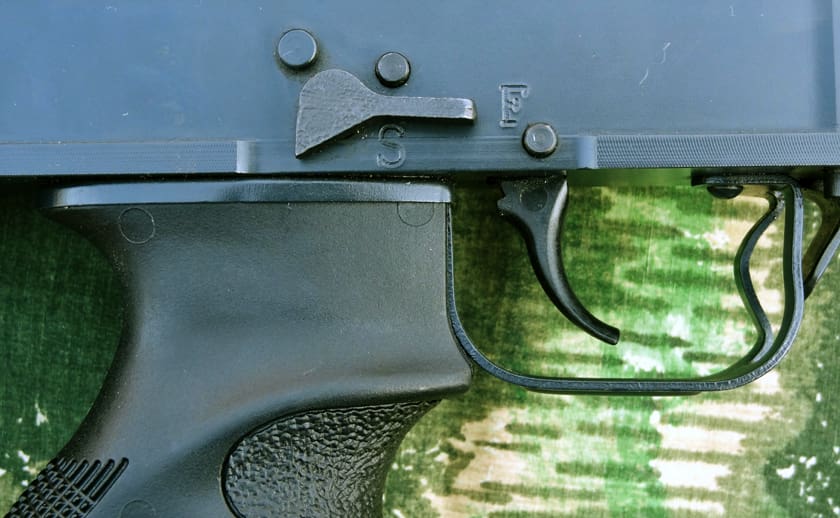
You don’t hear many complaints about the imported versions of the Czechpoint Vz. 58, but when you do, it’s usually about the trigger: the trigger in the D-Techniks/CSA imports are made out of polymer. The gripe is not that they break; rather it’s simply that they are made out of plastic. Kind of like dudes who gripe about GLOCKs, I guess. Truth be told, I’ve got no complaints, but if the thought of a plastic trigger freaks you out, Bonesteel Arms will sell you a steel replacement.
Putting the whole plastic thing aside. I think the D-Techniks Vz. 58 has one of the best triggers of any com-bloc military rifle I’ve fired. In fact, I’d stack it up against most any other military semi-automatic rifle, from HKs to AKs, with perhaps the exception being the new breed of aftermarket, non-mil-spec AR triggers.
Having said that, the Vz. 58 trigger takes a bit of getting used to. It starts out with 3/8 inch or so of easy take up, and then you hit a nice “wall” like you would on a typical U.S. two-stage military trigger. However, the trigger doesn’t break just past the wall, as it does with a nice AR trigger. Rather, the trigger continues to the rear in a smooth and steady manner for another 1/4 to 3/8 of an inch (or so), finally breaking without any further wall or warning. In some ways, it reminds me of an HK MP5 trigger, only lighter and smoother.
It’s a trigger that is somewhat difficult to master, but it will really reward you if you apply your fundamentals and concentrate on squeezing the trigger. Fired correctly, the trigger’s break will surprise you every time. Personally, I think the trigger on my D-Teckniks is really excellent, but again, it took a ½ hour or so to get the hang of it.
In contrast, the trigger on my CAI Vz. 2008 is not as nice. It’s not horrendous, mind you. But the fact that Century Arms designed their own sear, disconnector, and trigger feather spring leads to a heavier, albeit perhaps more robust, trigger.
The paddle-style safety on both rifles is located on the right side of the receiver above the pistol grip. In the photo above, the D-Techniks rifle is shown with the safety selector in the “fire” position. When engaged in the safe position, it prevents the disconnecter from engaging the sear, and results in a very positive safety mechanism. When “on safe,” the lever protrudes downward into the area where one would normally hold the pistol grip, thereby giving the operator a tactile indication that is in “safe’ mode. Moving the safety to a “fire” position requires the operator to move the safety forward and up 90 degrees. This replicates the movement required to place the weapon from safe to full-auto mode on the original design.
Most right-handed shooters will use their index finger on their trigger hand to accomplish this task, although some will be tempted to break their grip and use their thumb. The safety works independently of the striker, and can therefore can be manipulated regardless of whether the rifle is cocked. In the same vein, the rifle can be loaded or unloaded while the safety selector is in the “safe” position. Overall, I rate this safety as a solid improvement over the AK-47 design, but it is admittedly not as ergonomic as an AR-15 safety.
Although not technically an ambidextrous design, many left-handed shooters will be able to turn the safety to “fire” position by pushing it forward using the thumb of their firing hand. Flipping the safety down using the non-firing hand will place the rifle back in a “safe” condition. As an additional aside, North Eastern Arms makes an ambidextrous safety, but frustratingly they are out of stock more often than not.
The safety on the CAI Vz. 2008 is installed in a manner that replicates the safe-to-semi movement of the original design. In the photo at top left, you see the Vz. 2008 safety in the “safe” position. The photo at top right shows the safety in the “fire” position. As you can see, you have to rotate the safety clockwise (i.e. towards the rear of the gun) to get it in an operational mode. You pretty much have to break your grip on the pistol grip to accomplish this task.
The magazine release is located on the bottom left of the rifle, just forward to the trigger guard. Pushing forward on the release lever will release the magazine. It’s pretty ideal for a right-handed shooter, but difficult for a leftie. There are ambidextrous mag releases available as aftermarket accessories. These work well even for right handed shooters, as they allow the operator to drop the mag using the trigger finger of the shooting hand, similar to an M-16.
The follower of an empty magazine engages the bolt stop (see photo above), which is located forward of the trigger guard and to the right of the magazine release lever. The bolt stop can also be engaged manually, in a manner similar to a Ruger 10/22, HK G-36, or similar designs.
Barrel & Muzzle Devices
Czech Small Arms uses new production 15.4 inch, chrome-lined, cold-hammer-forged, four-groove barrels featuring a 1 in 9.5 inch twist. The barrels are manufactured by Lothar Walther in Germany, a company well regarded for making some of the best production barrels in the world. Based on my experience with these rifles, the ones made for D-Techniks / CSA are no exception.
The chrome-lining process will soon be performed in-house by Czech Small Arms. The following video shows how the barrels are pressed in to the receiver.
http://www.youtube.com/watch?v=CkPPGKqebJE
Note that CSA has to weld on a barrel extension to bring the barrel up to 16.25,” as required by Federal law. When I first purchased my D-Techniks, I figured I would be able to replace the muzzle cap/extension with an aftermarket AK flash suppressor. However, it turns out that the CSA Vz. 58 uses right handed threads, as opposed to the left handed thread on a typical AK variant. So much for that idea. I purchased a really nice “Crusader” muzzle brake from North Eastern Arms, but I have not had it installed yet.
CAI’s Vz. 2008 uses a U.S. made 16.25 inch barrel with a 1 in 9.5 inch twist. These barrels are not chrome-lined. It has been widely reported on the internet that these barrels are made by Green Mountain, but I have not independently verified that information. Nonetheless, my Vz. 2008 barrel appears to be well-made. I originally posted that the Vz. 2008 uses left handed threads common to AK pattern rifles. That apparently was not entirely correct. I called my gunsmith and he confirmed that my CAI Vz. 2008 has “14mm – 1mm right hand” threads. Czechpoint posts the following on their website pertaining to the Vz 2008:
THIS BRAKE WILL FIT ORIGINAL CZECH BARRELS WITHOUT ISSUE, BUT MANY CENTURY VZ2008 OWNERS HAVE EXPERIENCED ISSUES WITH SCREWING THIS BRAKE ONTO THEIR BARREL THREADS. JUST A HEADS-UP THAT THERE IS A LIKELY CHANCE THAT THIS BRAKE WILL NOT FIT THE CENTURY VZ2008 RIFLE WITHOUT CHASING THE RIFLE MUZZLE THREADS WITH A 14X1RH DIE. OR, THE BRAKE MAY NOT FIT THE VZ2008 WHATSOEVER AS SOME OF THESE RIFLES ARE THREADED LEFT HAND (OPPOSITE OF ORIGINAL VZ.58 THREADED MUZZLES). IF YOU PURCHASE THIS BRAKE, AND IT DOES NOT FIT YOUR CENTURY VZ2008, CONTACT US FOR RETURN INSTRUCTIONS – OF COURSE IT MUST BE RETURNED IN NEW/UNMODIFIED CONDITION.
So, again, Century buyer beware.
Sights
The sights on all Vz. 58s are the typical combloc design, and consist of an open notched leaf rear and a wing-protected front post front. The front sight is adjustable for windage using a tool, and can be screwed up or down to adjust for elevation. The rear tangent sight is adjustable for elevation to 800 meters. It also features a “U” (“univerzální”) marking, which is used a 300 meter battlesight zero.
The sights on my D-Techniks are right on the money, because they get checked and test fired before they leave the factory. The Century Arms Vz. 2008s are a bit more hit and miss in the department. While my sample had sights that were close enough to be considered acceptable, it is common to find samples that are significantly out of alignment.
There are three options for mounting optics. First, CSA manufactures a Picatinny scope rail mount that replaces the receiver cover. CSA also manufactures a side mount plate to the receiver. Finally, the most common optic solution is to use a mount with replaces the top handguard.
Metal Finish
All CSA rifles are phosphated, and then a baked-on finish is applied on top of the phosphate. The finish is baked at 300F degrees for one hour. This finish is extremely durable – similar to a KG Coating’s Gun Kote.
The finish on the Century Arms Vz. 2008 is simple parkerization over bead-blasted metal. Its adequate to get the job done but that’s about all you can say about it.
Furniture
In true commie style, the Vz. 58’s stock furniture is a cheap-looking, wood-chip impregnated plastic that vaguely resembles particle board. Despite the cheap looks, the furniture functions well and is very durable and long-lasting. Colors can vary in shade from a medium color red to a dark color red (and can exhibit slight variations in hue, such as: reddish brown and reddish purple). The wooden stock has a short length of pull, similar to a Warsaw length stock on an AK. In the photo above, the black handgrip is a U.S. made 922r compliance part, whereas the other parts are all Czech-made mil-sup “factory” parts.
One nice thing about the Vz. 58 furniture is that owners can switch between the factory side-folder and the fixed butt stock with nothing more than a large flathead screwdriver. However, owners of Vz. 2008s need to be forewarned: some of these guns have been built so far out of spec that aftermarket parts won’t fit. In talking about this issue with the guys from the Mako Group, it appears that aftermarket parts fit on some Vz. 2008s but not others. In most cases, you can get them to fit with some hand fitting. However, aftermarket parts will not be returnable if you bubba them in your effort to get them to fit.
Magazines
The alloy magazine of the Vz. 58 is a proprietary design, and is not interchangeable with an AK-47 magazine. The fact that it doesn’t use AK mags seems to be a source of great frustration for many, and I’ve heard some refer to it as a “deal-killer.” Frankly, I don‘t understand this complaint. The Vz. 58 mags are roughly half the weight of the steel AK-47 magazine. They rock into place more easily than the mags made for the AK-47, and have none of that annoying wobble that is common to the AK builds you see here in the states. They’re easy to load to capacity, and as mentioned earlier, the mags can be loaded from stripper clips by using the rifle as a guide. Based on appearance and feel, one would expect it to be not as strong as a steel AK magazine, but I have only run across one surplus mag that did not work as advertised.
Granted, they aren’t as ubiquitous as AK mags, and I am not aware of after-market substitutes. Nonetheless, extra mags typically run $15-20 for used surplus, and $25-33 for new magazines. I’ve only got 15 or so, so I need to get some more!
Disassembly
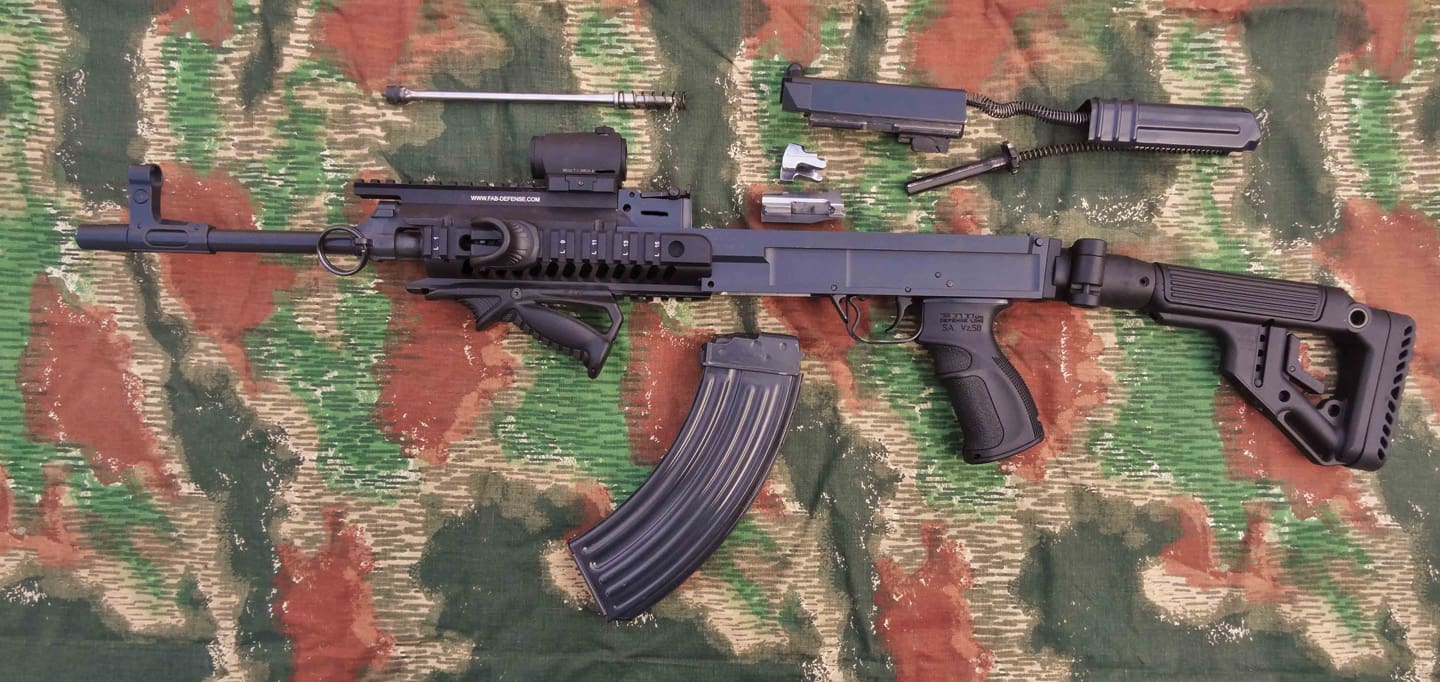
Although different than an AK, disassembly takes only a slight amount skill/thought. You begin by making sure the striker is in a forward, uncocked position (i.e. by pulling the trigger on an empty chamber, similar to a Glock). You then move the captured pin located on the receiver cover from left to right. The receiver cover (and attached springs) can be removed once this takedown pin is out of the way. Once the receiver cover is removed, the bolt carrier group slides up and out of its rails in a manner similar to an AK.
Once apart, the bolt can be removed from the bolt carrier, and the striker can be removed from the bolt carrier. This later operation is a bit tricky at first. You first pull the striker all the way to the rear, then return it approximately a ¼ inch forward and then twist in a counter clockwise motion for 20 degrees or so and then pull outwards. It may sound complicated, but in practice its pretty easy once you get the feel for it.
The gas piston rod is easily removed once the top handguard is taken off the rifle. The top handguard is held in place by a single captured retaining pin, not unlike an AR-15 pin.
Assembly is simply the reverse operation. The only tricks you need to know are: 1) the locking lugs should be in a retracted/unlocked position as you guide the bolt carrier group back on the recover rails, and 2) the striker should be in the forward (uncocked) position before attempting to reinstall the receiver cover.
One important safety note: It’s possible to reassemble the rifle without the locking piece installed onto the bolt. If you fire the rifle without the locking piece installed, you re going to get a ka-boom, which will ruin your day, to say the least.
Accuracy
Let’s face it: the two biggest inhibitors to good accuracy on most military rifles are the triggers and the sights. As mentioned above, the Vz. 58’s sights are typical com-bloc, warts and all. So I did most of my accuracy testing with an Aimpoint T-1 red-dot sight.
When I first started accuracy testing the D-Techniks Vz. 58, I was only getting 2-3 inch, 3-shot groups at 50 yards using CAI’s “Red Army Standard” steel cased Ukrainian-made ammo and an Aimpoint T-1 red-dot. Not good. But when I really started concentrated on my trigger fundamentals, I got those groups down to about one inch (2 MOA-ish) at 50 yards. I then switched to Federal “American Eagle” brass-cased ammo and immediately started turning in a string of ½ inch (+/-) three-shot groups.
With my confidence in myself and the gun restored, I then ran the targets out to 100 yards and was rewarded with a string of 5-shot groups what averaged just a hair over 1 MOA. A photo of one of those “typical” groups is posted above. Please overlook the fact that I used Yugo mil-sup ammo in the photo above– I had run out of American Eagle by the time I got around to taking the pics.
In any event, I’m confident that I could even achieve a few sub-MOA 5 shot groups if I used a magnified optic and more of the (admittedly expensive) U.S. brass cased ammo. But honestly, I’m not sure I want to bother with a magnified optic placed out on the handguard rail. Perhaps I’ll try to get one of the new picatinny rail equipped receiver covers from CSA (if they ever start importing them) and mount an IOR Valdada 1x-4x Pitbull scope on it. In the meantime, I am content with the 1 MOA accuracy I was getting with the Aimpoint T-1. Hell, for the money the 2 MOA I was getting with Tulammo or Red Army Standard is pretty decent at half the cost.
I have not done any formal accuracy testing with the Vz. 2008 because its still in the shop getting repaired. Once I get it back, I will update this section of the review with accuracy results.
Reliability
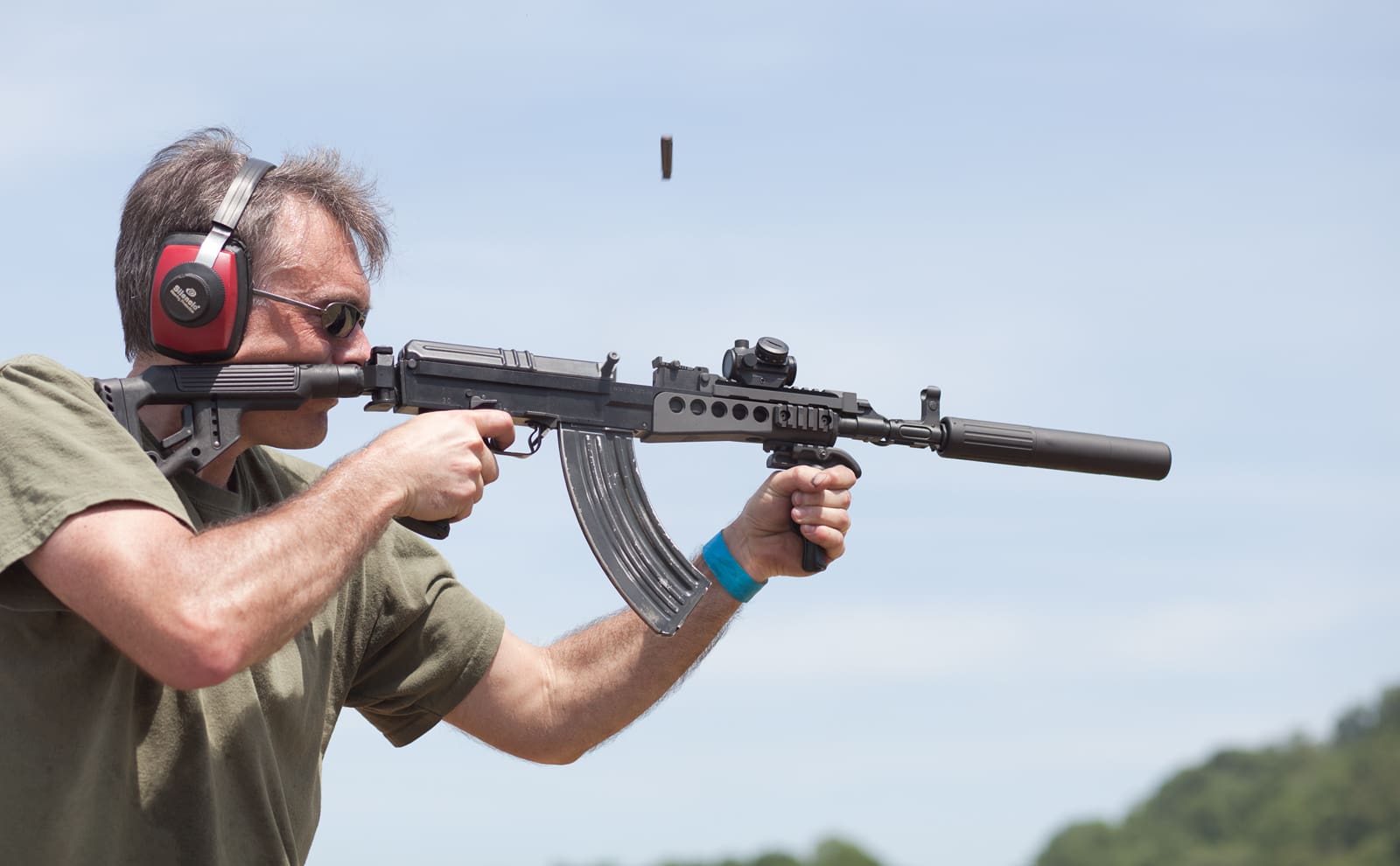
When it comes to reliability, the design of the Vz. 58 is sound. I will state in full disclosure that I’ve had some problems with both of my Vz. 58s, but for reasons that I will explain below, I still have full confidence in this weapon system.
First, the sear on my second-hand D-Technics Vz. 58 broke off after around 700 rounds, rendering the weapon inoperable. According to Mr. Dan Brown of Czech Point USA, my rifle, serial number Vz. 58 011XX, was one of the first batch (circa 2006-ish) that were built with the new BATFE-approved semi-auto sear. Apparently, the U.S.-made sear on this initial batch was flawed, but that issue was soon identified and fixed by redesigning the sear. Dan sent me out a new upgraded sear for free the same day I called, despite the fact that my rifle was well past its 5-year warranty and I was not the first owner. He even threw in some free swag in the form of a CSA logoed pen and some CSA stickers. Awesome customer service!
Since replacing the sear, I have put over 1,500 rounds through the rifle without any sear-related issues. Thus, as a precaution, it makes sense to upgrade to a current production sear if you have an early production run D-Techniks rifle.
In fact, I have only experienced two sets of malfunctions since that time. I tried a batch of cheap steel-cased soft points, and the gun would occasionally choke on these. Nonetheless, I ran at least 30 rounds of the new, uber-premium Winchester PDX-1 hollow-point ammo through the D-Technics with no problems. In March of 2014, I experienced two double-feed malfunctions using TulAmmo FMJ. Both jams occurred within a minute of each other using one of my older looking surplus magazines. I have since determined that the mag’s feed lips were slightly bent out of spec. Since that day, I have run an additional 400-500 rounds through the rifle (using different mags) without issue. Based on these experiences, I remain highly confidence in the D-Techniks Vz. 58 Sporter.
The Century Arms International Vz. 2008 was another matter entirely. It ran great for the first 200 rounds or so before it went DMFB-DW on me. At that point, I started experiencing some light primer strikes. I tried switching ammo, but soon it would not fire any type of ammo. It took me a while to diagnose the problem; at first I suspected a broken firing pin was to blame. However, it turned out that the barrel was not pressed in tight enough, and had worked itself loose ever so slightly over the course of those 200 +/- rounds. This created a headspace problem that prevented the firing pin from reaching the primer.
I called Century and asked them to fix it under warranty. They declined, on the grounds that the one-year warranty had expired. I only had possession of the gun for a month prior, but apparently the gun had sat at my FFL for too long before I picked it up. Century has to be the only company I know that has a warranty that begins to run the moment the distributor or retail outlet buys the gun from the factory, as opposed to when the final end-user takes possession.
So I said to Century, “Ok, forget the warranty – please fix it and bill me.” They responded by stating that they did not perform non-warranty-related repair services, even on their own guns. Basically, they said I was on my own. Too bad, so sad. So the rifle is now at a local gun shop in Keizer, Oregon getting repaired. Tres lame.
Conclusion
Overall, the Sa Vz. 58 is a must-have addition for any collector of Cold War-era firearm design, as well for collectors just looking for a unique variant that uses Warsaw Pact 7.62×39 mm semi-automatic rifle, The Czech Small Arms Vz. 58 Sporter is a high-quality example of one of the more obscure military rifles of that era.
My CAI Vz. 2008, on the other hand, ended up having a major manufacture-related malfunction, which seems to par for course for the drunken monkeys at Century. Others have gotten lucky and bought Vz. 2008s that ran great. As always with Century, it’s the luck of the draw. You feelin lucky? The CAI Vz. 2008 may look like a good deal at first glance, but when you start comparing features, the CSA model comes out on top by a long shot:
CSA / D-Techniks Century Arms Int.
Czech Receiver, some mil-sup parts. Parts kit gun built on U.S. receiver.
Baked on enamel finish over parkerizing Simple parkerizing
Chrome lined Lothar Walther barrel No chrome lining in U.S. made barrel
Single feather spring; light trigger pull Double feather spring, heavier trigger pull
Safety moves forward for semi Safety moved to the rear for semi
Uses Vz 58 muzzle brakes God only knows.
2 mags standard One mag standard
No bayonet lug Bayonet lug
Works with aftermarket products Aftermarket parts may not fit / poor fit
5 year warranty Sketchy 1 year warranty
Excellent customer service Crapshoot customer service
Smart money is on the CSA. Buy one, you won’t regret it. Unfortunately CzechPoint USA seems to be out of stock quite often, so jump on it when they do get them in.
Specifications (D-Techniks / CSA Sporter):
Caliber: 7.62 x 39mm (5.56 x 45mm and .222 Remington variants also exist)
Action: Gas operated; tilting block, striker fired.
Barrel: 15.4 inches, with a barrel extension to bring the final length to 16.25 inches
Weight: 6.7 pounds unloaded.
Length: 34 inches. 25 7/8 inches with folding stock retracted.
Capacity: 30 round magazines.
MSRP: $950 to $1,200, depending on make and model
Ratings of D-Techniks/CSA Sporter (Out of Five Stars):
All ratings are relative compared to the other weapons in the gun’s category. Overall rating is not mathematically derived from the previous component ratings and encompasses all aspects of the firearm including those not discussed.
Accuracy: * * * *
The D-Teckniks rifle exhibited far better accuracy than a typical AKM; but the standard iron sights and trigger are a limiting factor.
Ergonomics: * * * *
Better than an AK; not as good as an AR. Having said that, once the operator learns the manual of arms for this rifle, he or she can employ this system with a great amount of speed and accuracy.
Reliability * * * *
Now that D-Techniks/CSA worked the bug out of the semi-auto sear, the semi-automatic versions of the Vz.-58 are just as reliable as their military predecessors. Chrome-lined bolt, piston, and barrel help with durability.
Customization: * * * *
It’s not an AK or and AR, so I can’t give it five stars for customization. However, between Fab Defense/Mako, North Eastern Arms, Bonesteel and others, there are plenty of aftermarket toys out there for the Vz. 58.
Overall: * * * *
One of the finest light-weight “assault” rifles around. I would especially recommend this rifle for users whose mission requires a light weight rifle. This would be my absolute first choice for operations in jungle environments or in forested mountainous terrain where a compact rifle is a necessity.


















